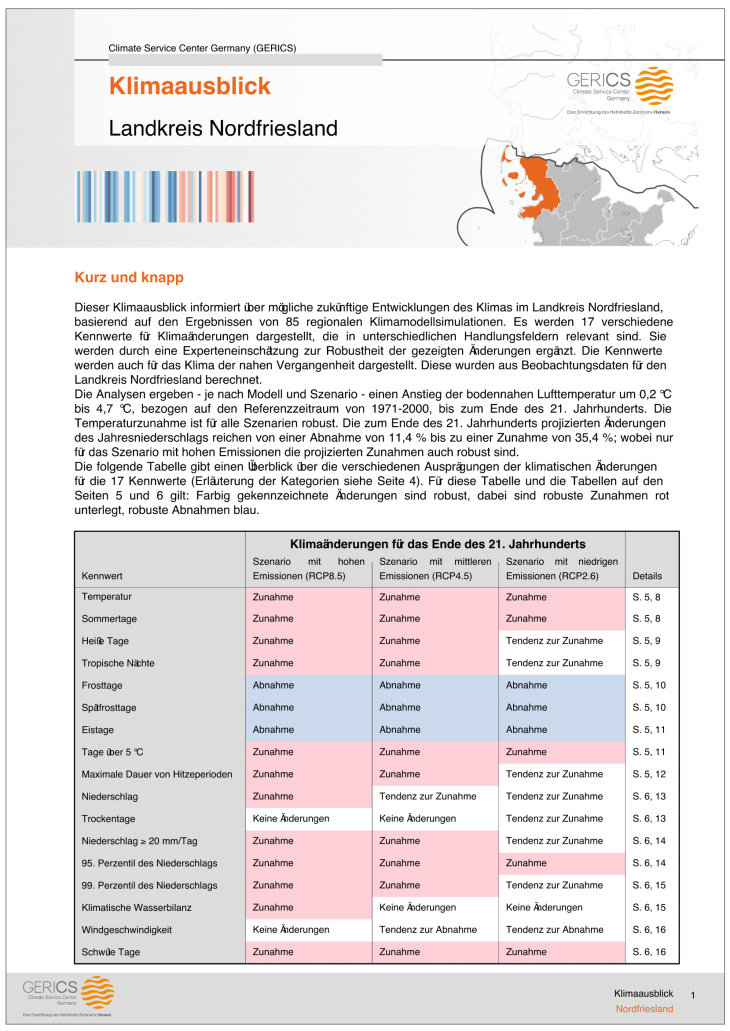Heavy rain and heat - new details on climate change
Possible climate changes on county level – a new climate service from GERICS
Global warming is advancing. The 1-degree mark has long been exceeded. The consequences are evident even in Germany: the number of hot days, for example, is increasing, and extreme weather events are becoming more frequent. But what does it look like in concrete terms by the end of this century? For this purpose, researchers at the Climate Service Center Germany (GERICS), an institution of the Helmholtz-Zentrum Hereon, have developed information sheets named “Klimaausblick” (climate outlook) for various regions and counties in Germany. In doing so, they provide possible climate changes for the coming decades based on 17 parameters.
The GERICS climate outlooks show climate changes at this regional scale for the first time. Each of the 401 climate outlooks is pooled at the county, district, regional district or city level; and summarizes the results for 17 climate parameters such as temperature, heat days, dry days, wind speed or heavy rain days on several pages. The results show projected development trends in climate parameters over the course of the 21st century: for a scenario with sufficient climate protection, a scenario with moderate climate protection and a scenario without effective climate protection. The advantage is that the reports are uniformly structured and thus allow clear comparison.
“The data shows how the climate may change in the individual German regions. This provides not only citizens but also decision-makers in business and politics with a factual basis for long-term decisions. For example, for urban energy suppliers or for the adaptation of infrastructures,” says Dr. Diana Rechid who is co-author of the reports together with Dr. Susanne Pfeifer and Dr. Sebastian Bathiany.
The data allow direct comparison

Grafik: Klimaausblicke GERICS
The analysis of the data took one year. The results show where climate change could be most severe in Germany. For each of the 401 areas examined, a climate outlook has been created individually. For example, the climate outlook for the county of Nordfriesland shows that that if emissions remain high, various climate and weather phenomena may increase by the end of the century. This applies to sultry temperatures, tropical nights, prolonged periods of heat wave and also heavy rain. In the mountainous regions of the Alps or the Black Forest, particularly strong warming is to be expected under such conditions.
“According to our research, there is not a single county in which everything would remain the same if emissions continued at the same level or even increased. The question is: What can we avoid through effective climate protection; and what changes do we need to prepare for in any case?” asks author Diana Rechid. Thus, the climate outlooks are not only a helpful source of information for experts, politicians and authorities. All citizens can compare the results of their hometown with those of other counties – be it due to a planned change of residence, a decision to acquire property or to protect themselves against climate change in general.
An elaborate methodology

Grafik: Klimaausblicke GERICS
The data analysis methods for the current reports are based on a new evaluation software called CLIMDEX that was specifically developed for this purpose at GERICS. In addition, statistical methods are used to calculate the “robustness” of the model results in order to assess the resilience of the projected climate changes. Since the analyses are standardized and fully automated, they will provide a good basis for quality approved evaluations in the future. The climate outlooks are based on observational data from the HYRAS dataset of the Deutscher Wetterdienst (DWD) and on future projections of regional climate models.
The Helmholtz-Zentrum Hereon is part of the Helmholtz-Klima-Initiative, where researchers perform research on climate change at systemic level. A total of 15 Helmholtz Centers combine their climate expertise in 13 research projects. GERICS directs the Cluster Netto-Null - Pfade zur Klimaneutralität 2050.
